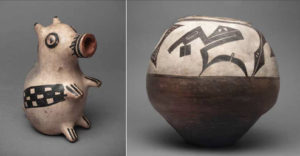Sharing the Spirit

Pueblo Pottery through Indigenous Eyes
When Grounded in Clay: The Spirit of Pueblo Pottery opened at the Museum of Indian Arts and Culture on July 31, 2022, it provided ethnology curator Tony Chavarria (Santa Clara Pueblo) a rare opportunity to showcase some “unexpected” items from the museum’s collection.
While the exhibition’s more than 100 historic and contemporary works of Pueblo pottery are drawn from two significant collections—the Indian Arts Research Center of the School for Advanced Research in Santa Fe and the Vilcek Foundation of New York—the Museum of Indian Arts and Culture contributed 12 works for the show’s Santa Fe debut. Those works will not be included when the exhibition travels to New York’s Metropolitan Museum of Art, but Chavarria says they have important things to say to local viewers, especially children.
“The last thing I wanted to do was a ‘best of ’ from our collection. We can always do a retrospective,” he says. Instead, Chavarria selected “smaller pieces to not crowd the vitrines. A few are broken, several are figurative and some could even be dismissed as tourist art. But all, broken or not, have an important story to tell.”
Chavarria selected figurines as a way to represent how pottery making is passed down through generations. “Making figures is the first thing master potters teach Pueblo kids,” he says. “Remember when we were kids and we’d roll Play-Doh around in our hands making long snake-like figures or stick figures? Well, it’s the same when a master potter rolls clay into ‘snakes,’ which is really the first step of coil and scrape. From there, coiling leads to bowls and jars.”
Figurines also “make people smile,” Chavarria continues. “I was hoping to engage children as perhaps they may be reminded of their toys.”
As a whole, Grounded in Clay represents pottery making traditions from 19 New Mexico Pueblos, Ysleta del Sur Pueblo in Texas and the Hopi tribe of Arizona. The featured works were selected by the Pueblo Pottery Collective, which was established in 2019 as an initiative of the Indian Arts Research Center. This diverse group of Native Americans from 21 tribal communities in the Southwest was formed to both curate the exhibition and write about the works, providing completely Indigenous perspectives on the history, past and present, of Pueblo pottery.
Each of the collective’s 60 members chose up to two works on display. Their writings recount their personal reflections and impressions about the pottery for viewers.
“This was one of the most collaborative projects I’ve ever been involved with,” says Chavarria, a member of the collective. “I felt truly valued and vital to the project.”
Perhaps the most historically significant work selected by Chavarria from the museum’s collections is the famed Sandia Pot. This is a very rare example of Sandia Pueblo pottery, in part because of its large size and because the clay used at that time resulted in especially brittle pottery. It is one of few historic Sandia pieces remaining.
Following the Grounded in Clay curatorial model, Chavarria also invited tribal representatives to add their personal narrative to each piece from the museum’s collection.
“This exhibition really helps to establish a new model and shows we can work with communities to be authentic and genuine,” he says. “We could do more of these community-based exhibitions, maybe at least every couple of years. But they can be expensive to mount.”
Thanks to private support, local museum viewers and visi-tors will be first to experience Grounded in Clay before it travels nationally in 2023. ”We could not have done this exhibition without some of the proceeds from this year’s Native Treasures art sale and support from donors to the museum Exhibitions Development Fund of the Museum of New Mexico Foundation,” Chavarria says.
This article is from the Museum of New Mexico Foundation’s Member News Magazine Fall 2022. Left Iamge: Cochiti Pueblo figurine. Gift of Dr. Phyllis Harroun. Right Image: Ako polychrome jar. Photos courtesy Museum of Indian Arts and Culture.


Connect